This comes to you a couple of days early, but the clocks have just changed to British Summer Time in the once United Kingdom and there is news to impart.
JAXA Arctic sea ice extent has fallen to the lowest level for the date in their satellite era records going back to 1979. This graph shows every year since 2000:
The high resolution AMSR2 regional graphs make clear that the precipitous drop on the Pacific periphery has continued: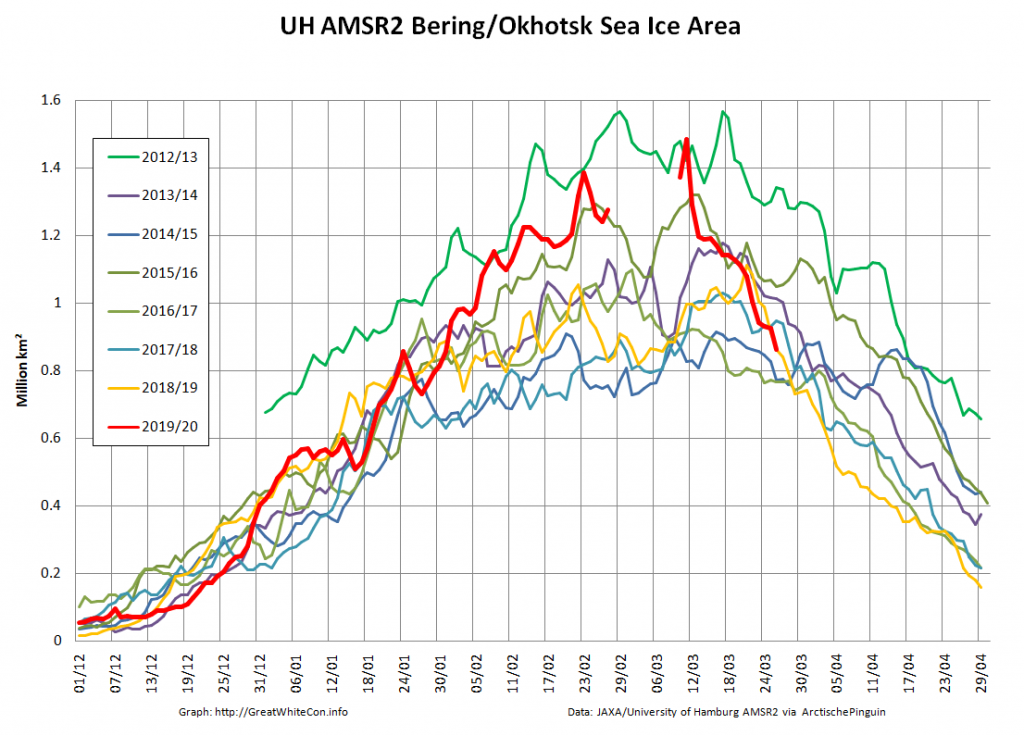
The current combined SMOS/SMAP Arctic sea ice “thinness” map makes clear that there is plenty more thin ice ready for melting in the Sea of Okhotsk and Baffin Bay:
There is also a large area of thin ice in the Laptev Sea, which will be interesting to watch once the 2020 melting season gets underway in earnest.
Today is All Fools’ Day, but this is no joke. Thanks to the consistent polar vortex over the Northern Hemisphere winter there is currently an anomalous “ozone hole” over the North Pole. As recently described in Nature:
A vast ozone hole — probably the biggest on record in the north — has opened in the skies above the Arctic. It rivals the better-known Antarctic ozone hole that forms in the southern hemisphere each year.
Record-low ozone levels currently stretch across much of the central Arctic, covering an area about three times the size of Greenland. The hole doesn’t threaten people’s health, and will probably break apart in the coming weeks. But it is an extraordinary atmospheric phenomenon that will go down in the record books.
“From my point of view, this is the first time you can speak about a real ozone hole in the Arctic,” says Martin Dameris, an atmospheric scientist at the German Aerospace Center in Oberpfaffenhofen.
Here are the latest graphics from the “Arctic Ozone Watch” section of the NASA web site:
Observations made during the still ongoing MOSAiC expedition, have confirmed the satellite derived measurements:
This year, powerful westerly winds flowed around the North Pole and trapped cold air within a ‘polar vortex’. There was more cold air above the Arctic than in any winter recorded since 1979, says Markus Rex, an atmospheric scientist at the Alfred Wegener Institute in Potsdam, Germany. In the chilly temperatures, the high-altitude clouds formed, and the ozone-destroying reactions began.
Researchers measure ozone levels by releasing weather balloons from observing stations around the Arctic (including the Polarstern icebreaker, which is frozen in sea ice for a year-long expedition). By late March, these balloons measured a 90% drop in ozone at an altitude of 18 kilometres, which is right in the heart of the ozone layer. Where the balloons would normally measure around 3.5 parts per million of ozone, they recorded only around 0.3 parts per million, says Rex. “That beats any ozone loss we have seen in the past,” he notes.
I’ve previously conjectured about the potential effect of the strong polar vortex on Northern Hemisphere snow cover this Spring, and here’s NOAA’s current snow extent graph:
JAXA extent’s precipitous recent decline has abated, and it’s now 5th lowest for the date in the satellite era:
Here’s the March 31st PIOMAS Arctic sea ice gridded thickness map:
together with the traditional volume graph:
Wipneus comments on the Arctic Sea Ice Forum that:
Ice is thickening impressively against the Canadian Archipelago and North Greenland.
That is indeed the case with the PIOMAS “modelled” numbers, but is much less obvious in the latest CryoSat-2/SMOS “measured” thickness map where ice over 4 metres thick is still conspicuous by its absence North of Greenland:
Plus a bonus graph for “Turbulent Eddie”, who suggests that:
[There’s] not much thick ice on the East Coast of Greenland, indicating the increase was from reduced loss through the Fram Strait?
together with the latest AARI ice age map:
Here’s the latest update of our novel NRT volume metric:
I’ve applied a crude correction to the still problematic NRT data so that it at least coincides with the reanalysed data on March 14th. Whilst we await the reanalysed numbers for the rest of March and early April it looks as though Arctic sea ice volume reached at least a temporary peak on March 20th 2020.
Here’s another update of our novel NRT volume metric, still incorporating my “fudge factor”:
Note also this handy hint from Stefan Hendricks on Twitter:
The reprocessed #Cryosat2 data is fine though and for the recent winter there is a corrected CS2SMOS version: ftp://ftp.awi.de/sea_ice/product/cryosat2_smos/v202_2/
— Stefan Hendricks (@sthendric) April 19, 2020
Wipneus has crunched the mid month PIOMAS gridded thickness numbers. Here’s the result:
The discrepancy between the PIOMAS model and the CryoSat-2 “reality” is still very evident.
With another week’s worth of reanalysed data now processed, it now seems certain that the CS2/SMOS Arctic sea ice volume maximum was 18469 km³ on April 6th:
The high resolution AMSR2 area and extent metrics are now both “lowest for the date” in the AMSR2 record:
JAXA/ViSHOP AMSR2 extent isn’t quite there yet:
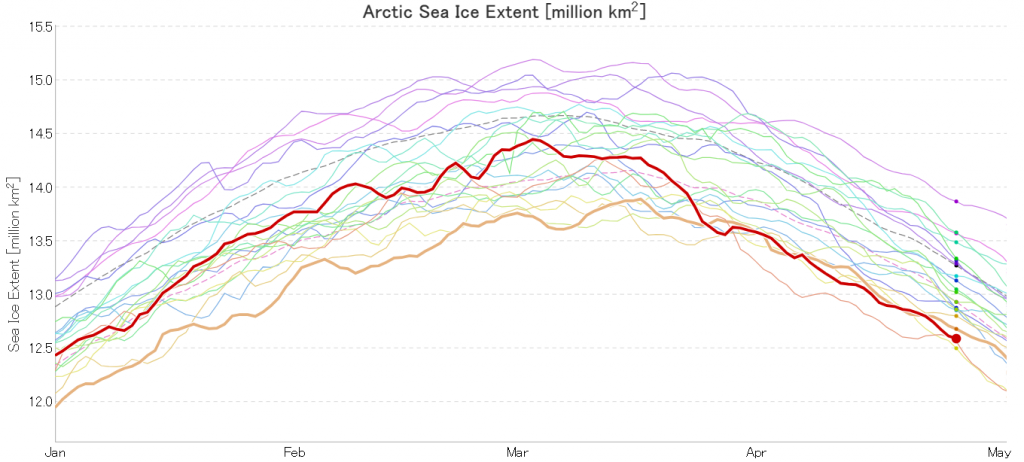
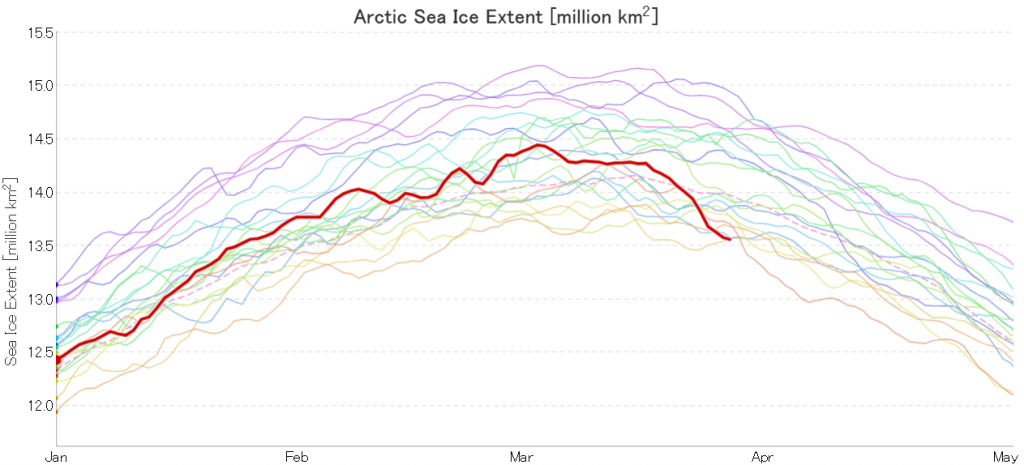

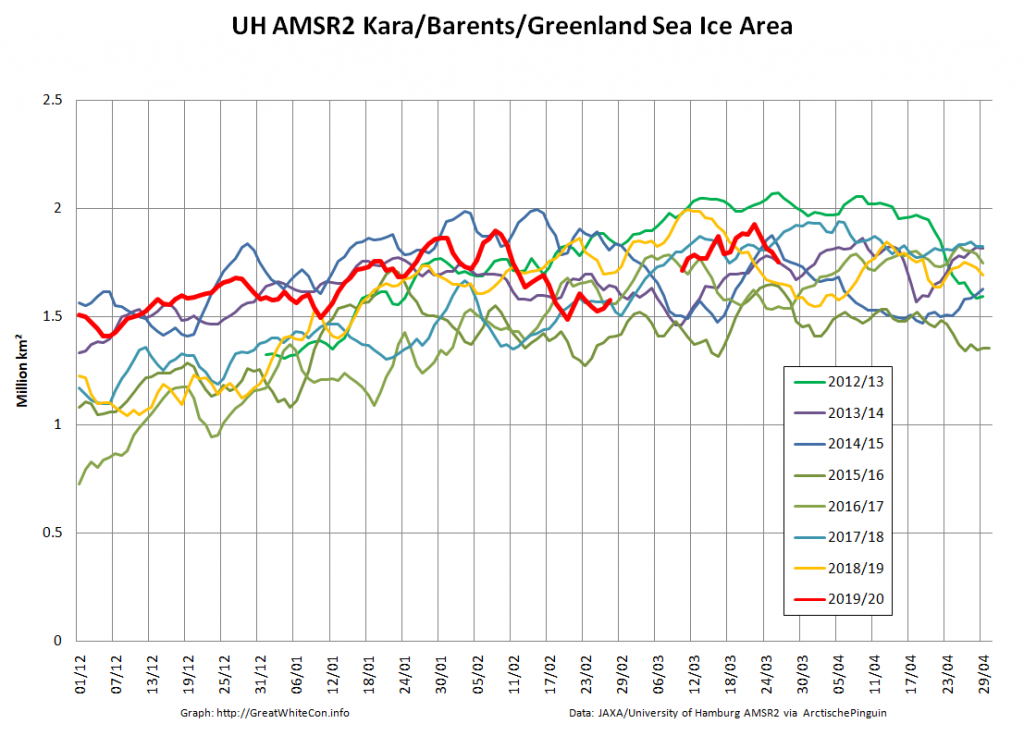
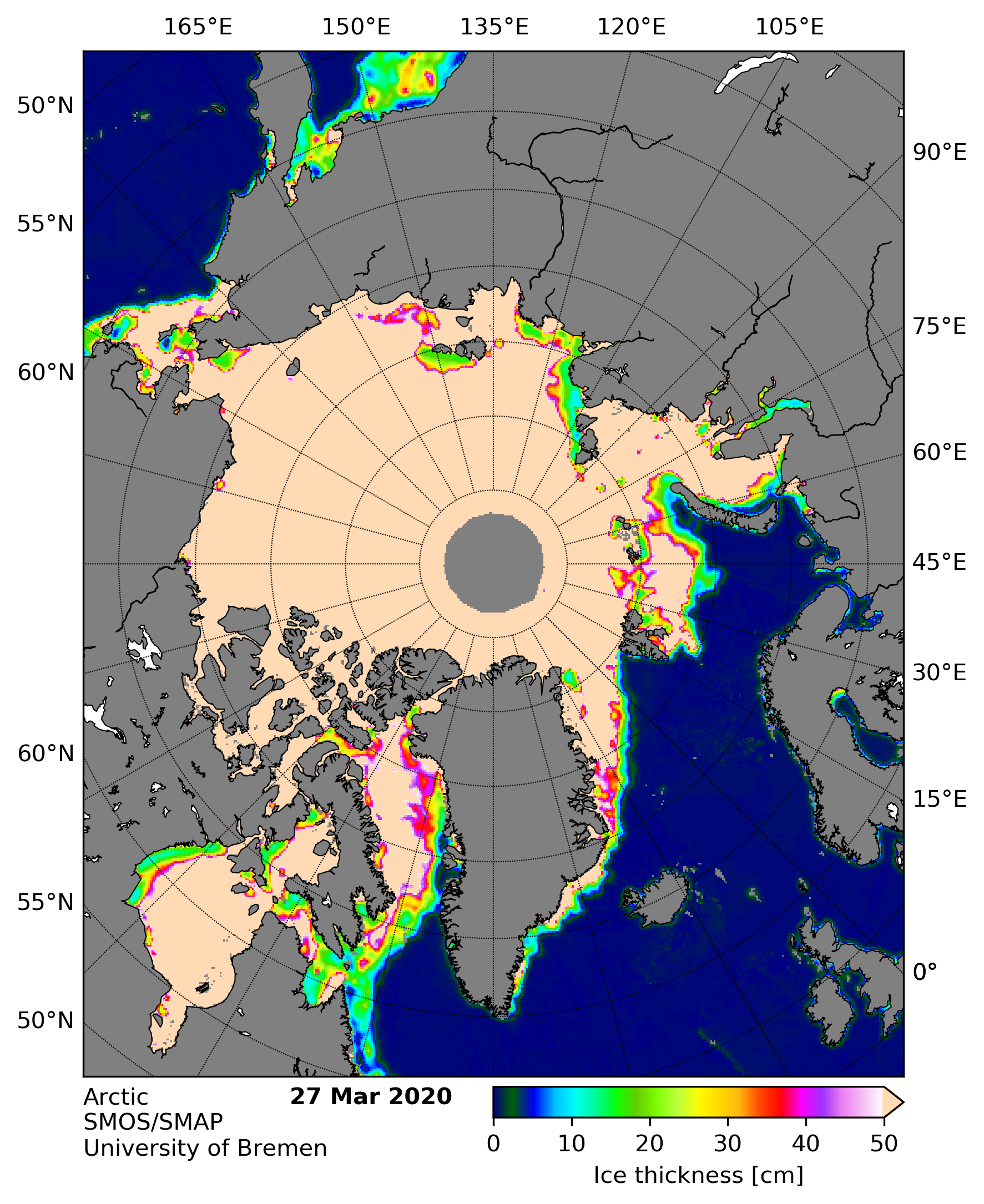
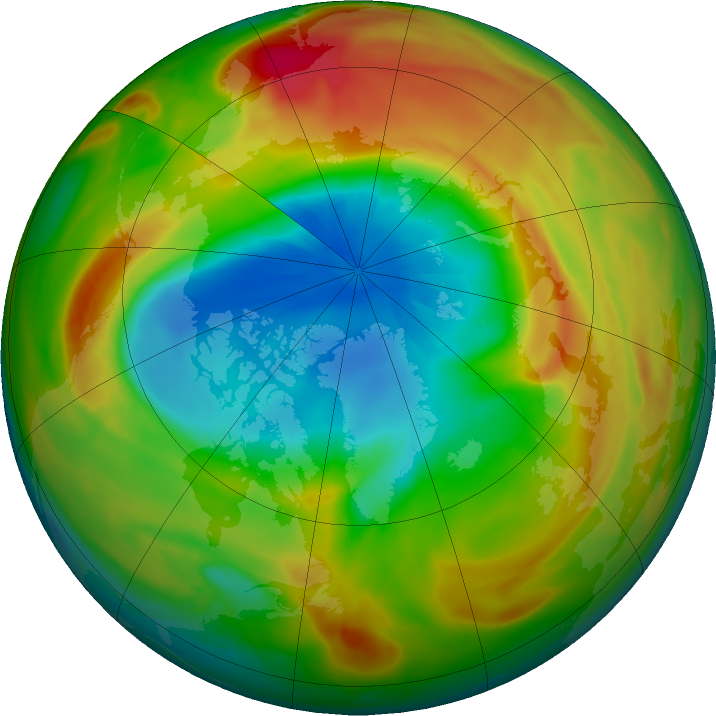
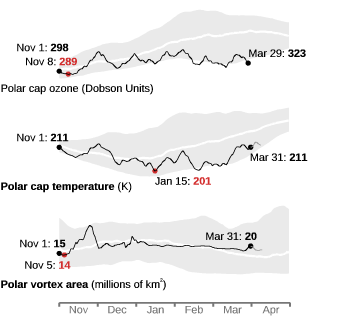

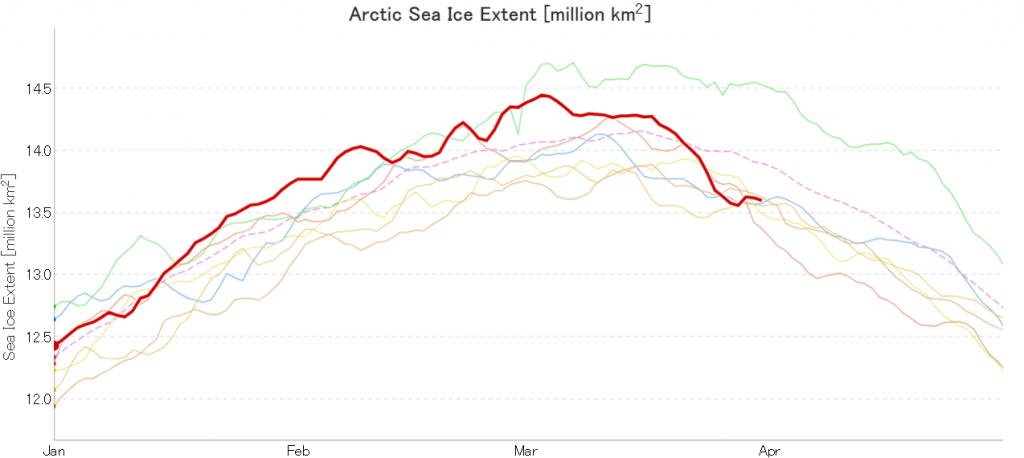
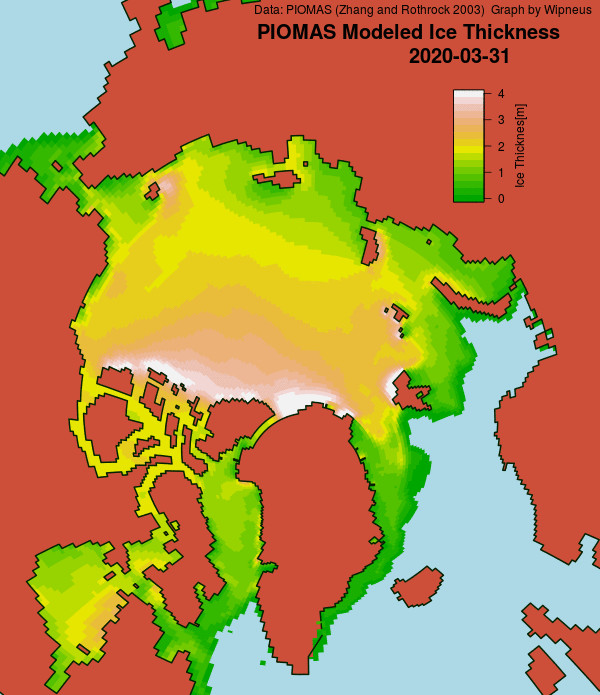


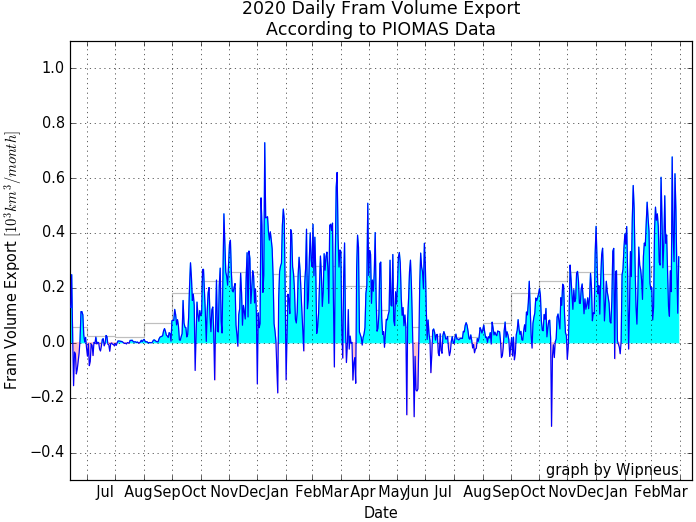
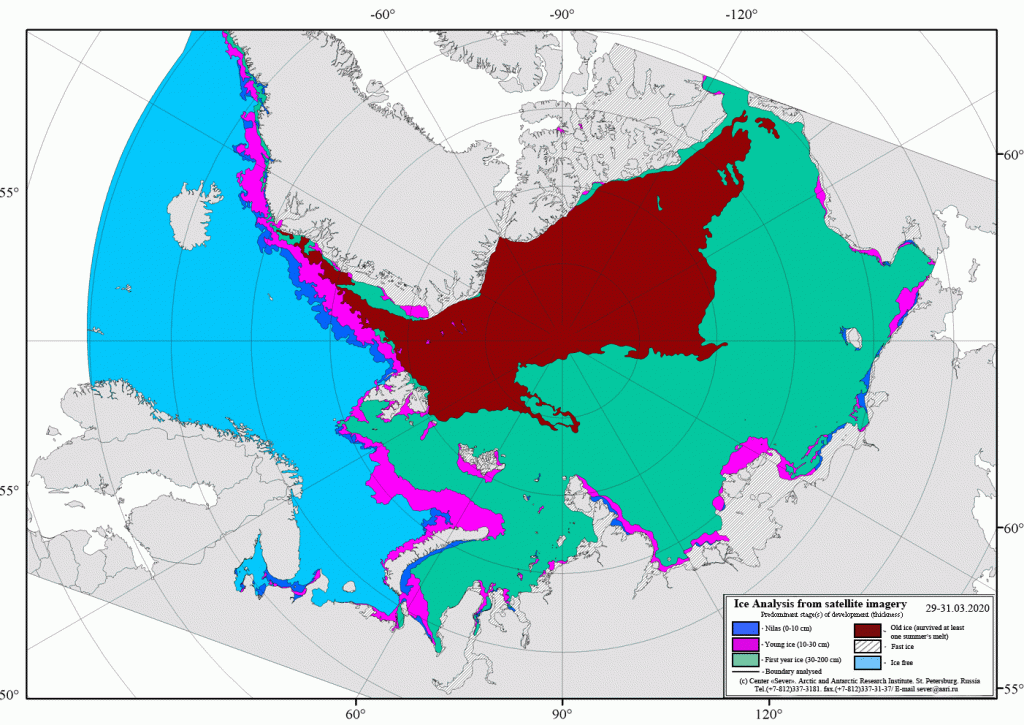
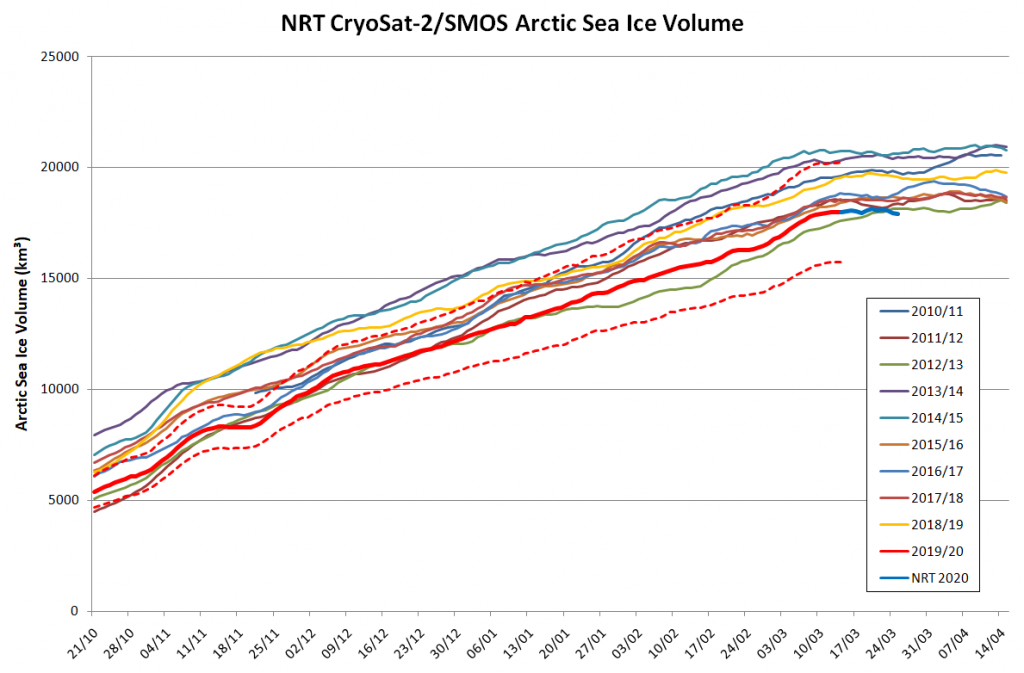

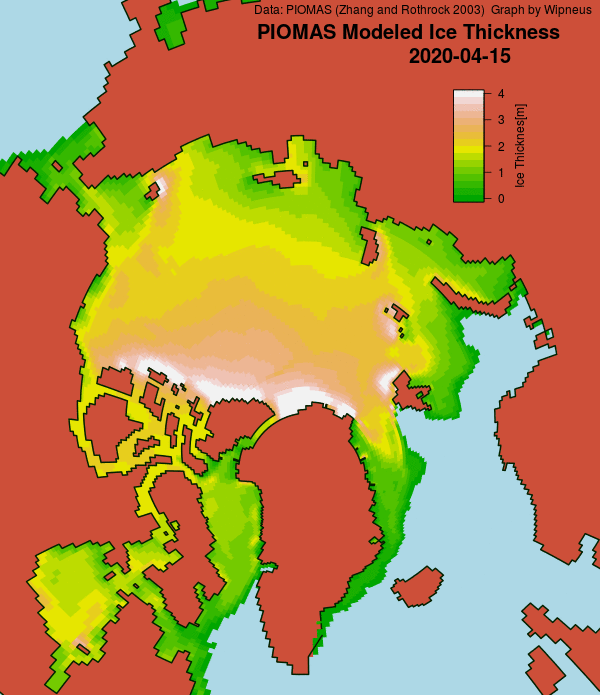
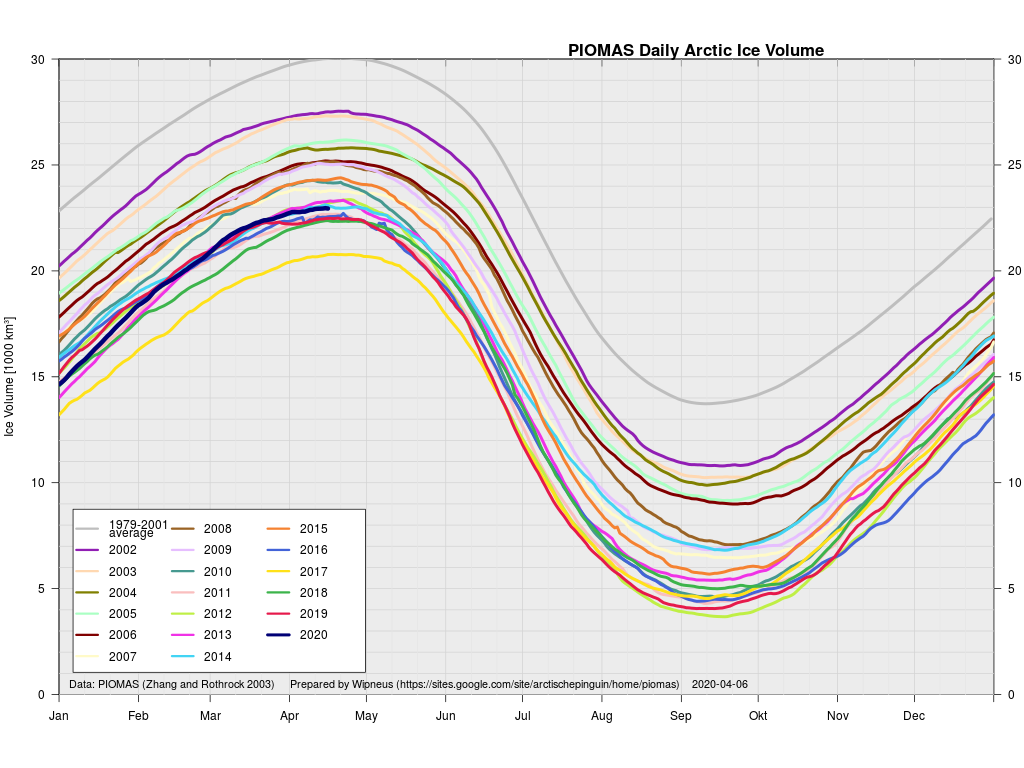
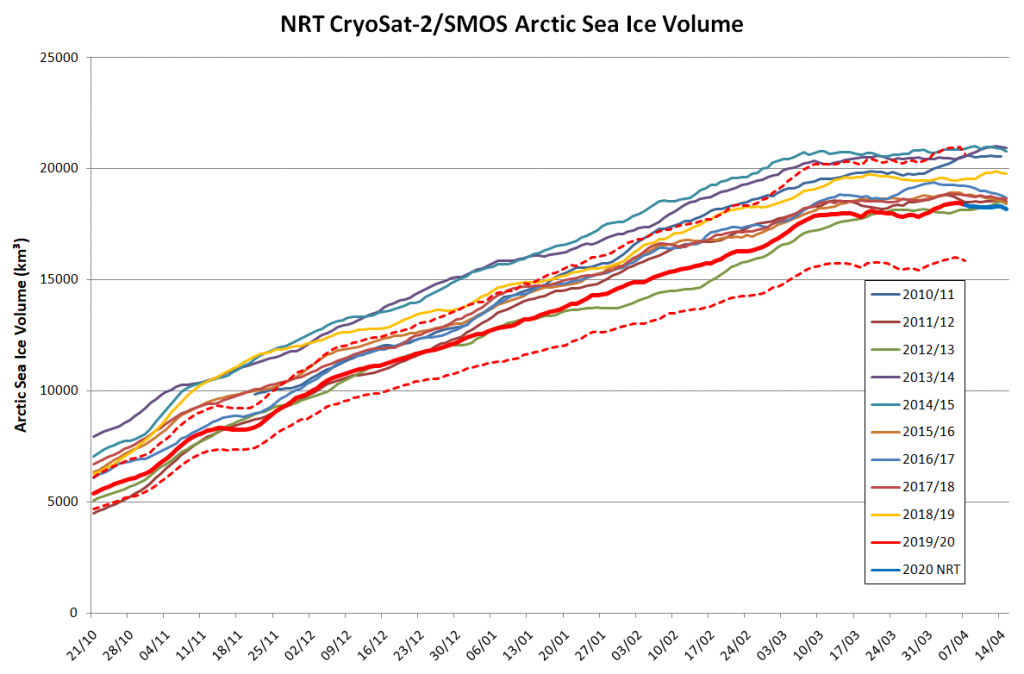
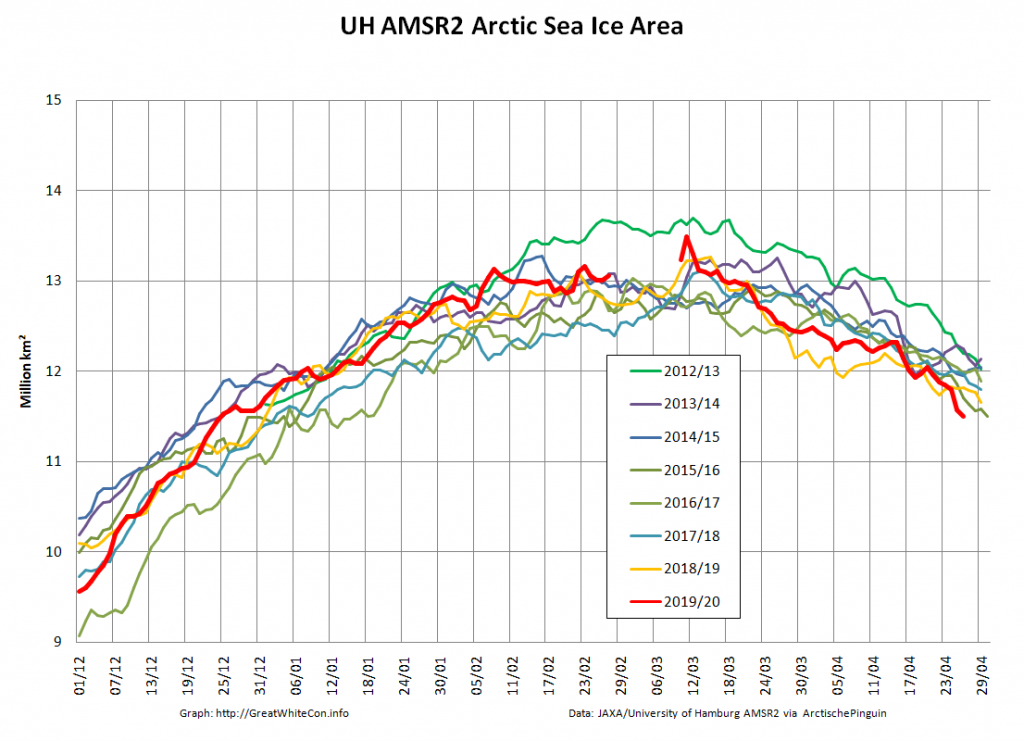
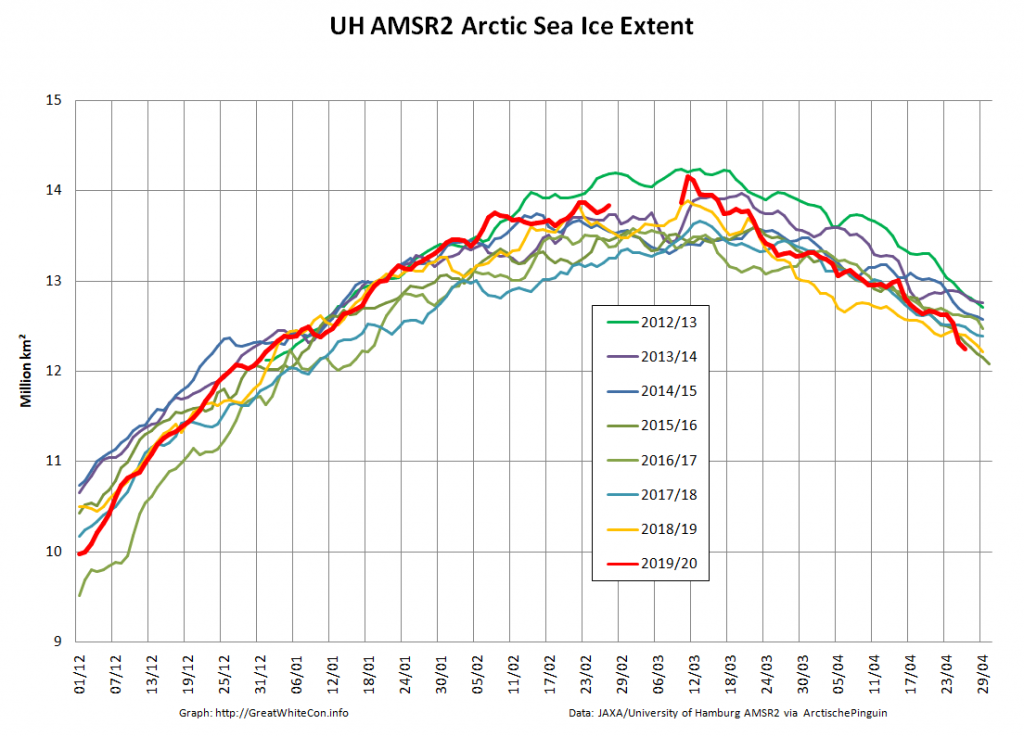
Another year without much ice to speak of in the Gulf of St. Lawrence very nearly none actually. The Labrador coast has been very thinly iced and even Ungava Bay looks suspiciously thin. Northwestern Hudson Bay is showing a lot of either open leads or very thin snowless ice. On the up side no BOE yet!!
Hi Red,
It sounds as though you’re local to the Labrador vicinity?
A blue Arctic Ocean event is some way away! However across the water from Ungava Bay the 2020 blue Disko Bay event has already taken place. This is from March 22nd:
Its just nuts! The thing that bugs me most about sea ice coverage/concentration is the published graphs from the trusted organizations that produce them. I just recently seen a sea ice thickness gif (can’t find it now of course) that shows The Gulf of St. Lawrence mostly skimmed over on 31 March. The first link is from Climate Reanalyzer showing a fair bit of ice in the gulf on 26 March. The second is from EOSDIS Worldview 25 March. The third one is from the Canadian sea ice service 4 April. I feel that these differences, if repeatable to most of the periphery, would have a large effect on the numbers.
https://climatereanalyzer.org/clim/seaice/
https://worldview.earthdata.nasa.gov/?v=-72.56149213143806,42.00461668426533,-51.094376915105244,52.46983535222758&t=2020-03-25-T10%3A59%3A18Z
https://iceweb1.cis.ec.gc.ca/Prod/page3.xhtml
Your 3rd link doesn’t work, since I haven’t performed whatever search on the CIS web site took you there.
You need to open the image you’re looking at in a new tab or window and post the link to that.
Could it have been this one by any chance?
https://ice-glaces.ec.gc.ca/prods/WIS28C/20200404180000_WIS28C_0011013137.gif
Yes Jim sorry about that. Computer skills are not really my world.
OK!
There are all sorts of issues when trying to reconcile satellite data, even MODIS “true color” imagery, with the CIS maps and on the spot visual evidence. See the annual Northwest Passage threads for a host of examples:
https://greatWhiteCon.info/2018/08/the-northwest-passage-in-2018/
DMI temp is steadfastly warmish. If you’re also saying thickness and volume have become well identified problems then the world should be looking at major changes this decade. (I think population is getting close to 8 Billion now!)
I think Brexit and Trump remind us all we’re looking for change…
Here’s the current DMI freezing degree days graph:
Warmish, but not as warm as 2016 or 2017.
At the risk of drifting off topic, COVID-19 seems destined to bring change of some sort? However whether that leads to an ongoing increase in Arctic sea ice volume still seems highly doubtful.
Hudson and Ungava Bays on April 6th:
https://go.nasa.gov/2UQQ4fP